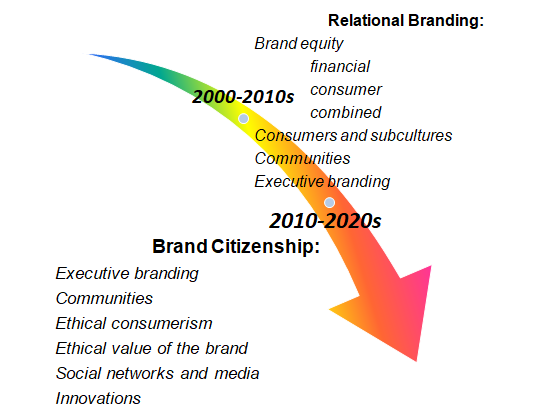Introduction
The concept of brands and branding is not new to the academic and business world. This concept can be traced down to the beginning of civilisation where headers branded their livestock for differentiation purposes (Mukherjee 2013).
However, development of major features of modern branding can be traced back to the 16th century when brands developed by individuals (such as Josiah Wedgwood and Rose Bertin) appeared (Mukherjee 2013). Due to the importance of branding in the business world, a number of procedures and theories have been developed with regards to this phenomenon.
This paper will explore development of the concept of branding, its relevant theories and concepts, development of branding within the last decade and expected directions that it might take in the next decade. Finally, the paper will include suggestions on areas that future research should focus on in the academic as well as practitioner point of view.
Literature Review on Branding Trends and Development
The twenty-first century is marked by attention to global issues which are related to environment, human health, and equality and so on. Clearly, companies could not remain intact and have to respond to the latest trends occurring in the society. Thus, development of brands is now connected (to this or that extent) to an issue which lies within the areas mentioned above.
Tustin and De Jongh (2008, p. 32) stress that companies employ the concept of brand citizenship which is development of a brand “by backcasting key business decisions throughout the value chain and business processes to reflect ethical implications at every decision-making point”. In other words, companies tend to add an ethical value to their products as well as brands.
Contemporary consumers are not satisfied with high quality and reasonable prices. They want to become a part of a process of development and improvement through their buying experience. It is possible to state that they are willing to buy from responsible companies that contribute to development of the community.
Thomas et al. (2013) also note that companies are trying to add certain ethical value by considering the US cereal brands. These brands were articulating the following messages: healthy eating and lifestyle, family values, happy and easy life. Admittedly, each product can be linked to a number of ethical values which will be shared by individuals as well as large communities.
Apart from ethical component of the brand development, companies pay a lot of attention to innovation. Brandt, Cazzaniga and Hann (2011) note that consumers want to buy really high-quality and innovative products which could address issues which are arising.
For instance, cosmeceuticals have to come up with innovative goods as consumers; needs are changing due to the change of the environment, cultural diversity as well as fashion and people’s preferences (Cazzaniga & Hann 2011). Clearly, companies providing other types of goods also have to introduce novelties to help consumers adjust to the changing society.
Brand Analysis over the Last Decade
During the last decade, the world has experienced tremendous changes especially with regards to the way of life and the manner business is conducted. Specifically, recognition of brands has grown significantly and they are now treated as business entities. Based on its importance, numerous companies consider their brand as their most valuable asset (Hill 2013).
This is due to the fact that brands in the last decade have acted as social and political weapons that have given entities power they need to stand at a competitive edge over their rivals. In this respect, it has been virtually impossible to distinguish between a company and its brand since they are considered as one and the same.
Google is one of the companies that have grown tremendously over the last ten years. During its early days, Google was considered mainly as a search engine. However, due to its efficient branding campaigns, the company is now regarded as a leader in the current technological era.
This firm has developed a strong brand identity all through its target group. As Back (2012) asserted, any individual who has intermittent or continuous use of the internet utilises at least one of Google products. To further develop its strong brand identity, the firm has been introducing new products and maintaining its successful ones over the years (see fig. 1).
This includes products such as the Google search engine, the android operating system, and Gmail. These products not only ensure that the Google brand remains relevant over time but also secure high competitiveness of the company. As a result, Google annual revenue increased by approximately 34% during the 2012/2013 financial year (Tulug 2013).
Fig. 1 Google (n.d.)

Samsung is another brand that has grown considerably over the last decade. Traditionally known for selling home appliances, this brand has grown to become the leader in the smartphone industry surpassing renowned brands such as Apple and Blackberry.
By the first quarter of 2013, Samsung had a market share of 30.3% in the smartphone industry and its annual sale for the 2012/2013 financial year for smartphones alone amounted to $5.2 billion (Tulug 2013). Just like in case with Google, success of Samsung over the last decade has been attributed to its branding strategies that aim at developing a strong brand identity.
Fig. 2 You know it’s Samsung (n.d.)

To achieve this, the firm introduced novelties such as the Samsung S4 smartphone and the Galaxy Note II whose features were innovative and creative and met the needs and expectations of its target market of young users. In realisation of the importance of brands in the contemporary world, Samsung invested heavily in marketing during the last decade.
For instance, Samsung spent approximately $4 billion on marketing in 2012 (Back 2012). To achieve effective positioning of its products, Samsung used celebrities such as Usher, LeBron James, and Didier Drogba as icons of the products so that it could strengthen its position globally.
In the contemporary world, social media have developed to become the most widely used platform that people and businesses utilise to create personal content and share it with the rest of the world (Harrison 2012). Due to its frequency of application, its high speed, and its wide outreach, social media play a significant role in determining the trends and events that are taking place in the society (Djellal & Gallouj 2012).
Myspace was one of the most renowned brands during the early days of social media. Despite the success that this brand enjoyed during its early days, poor management and marketing resulted in the demise of this brand.
Founded in 2003, the main target audience for Myspace was the youth population whose interests revolved around music bands, movies, and movie starts (Sherman 2012). This proved an effective approach in the short run.
Facebook, on the other hand, targeted college students who had a lot of interests in common such as sports, movies, books, education, language, and other hobbies that are capable of sustaining the site in the short as well as in the long run. Moreover, it was impossible for users of Myspace to design their pages to suit their tastes and preferences. Facebook users can easily adjust their profiles whenever they want.
These are some of the few factors that resulted in the demise of Myspace and, on the other hand, led to the growth of Facebook as the leading social media website. Thus, as a brand, Facebook has had the most positive contribution to the society since it enables individuals and other entities to interact and share ideas under a single platform.
Therefore, it is evident that the concept of branding was considered as a critical marketing tool during the last decade. For a given entity to be successful in the long run, it was critical for it to develop a strong brand identity. As has been mentioned above, brand identity comprises a number of branding theories and concepts.
Most importantly, it has emerged that the internal operation of a given entity is essential in the process of building a strong brand. Thus, firms over the last decade have developed and implemented strong micromarketing techniques in a bid of developing a strong brand (Parker 2012).
For a brand to be successful, it is essential for it to employ strong macro marketing strategies as a means of strategically positioning itself in the market, capturing the attention of its target audience by meeting their needs and expectations. This results in brand loyalty, profitability, and sustainability in the long run.
Views on Branding over the Next Decade
Views of experts
The concept of brands and branding has been changing over time and is expected to undergo further changes over the next decade. To determine how this concept will grow over the next decade, I conducted an interview with three experts in the field of branding.
The interview with Cliff Rosenberg, the managing director for LinkedIn ANZ and Brian Giesen, director of strategy at 360 Digital Influence mainly focused on an emerging field in branding called executive branding. According to these professionals, it is essential for employees to create and maintain professional personalities as a means of developing a strong corporate brand.
For instance, Virgin Airlines is a renowned corporate brand while Richard Branson is a strong character within this organisation. Admittedly, another example of this approach can be the role of Steve Jobs in development of the Apple brand.
Fig. 3 Steve Job’s quote (n.d.)

People were eager to buy a product from a company which is run by such an inspiring personality. The expert note that executive branding has already proved its efficiency and people will continue looking at their models while choosing this or that brand.
Facebook and Google are companies which show that the approach is effective as people tend to learn about the inspiring leaders. By using the product(s) of the company, consumers are trying to become members of the community of young and inspiring leaders. Thus, a really important value is added to the brand which is becoming more competitive.
Thus, it is critical for firms to ensure that their employees have strong executive brands with respect to the positions they hold within their organisation especially in this era of the internet and social media.
Employees are usually considered as an integral asset of a given entity since they represent its image with regards to its vision and mission objectives. Therefore, a strong brand will enhance the confidence that stakeholders have on a given firm especially from the perspective of its customers.
The interview with Barbara Kahn, the director of the Jay H. Baker Retailing Center revealed that the internet and social networking will play a critical role in development of brands over the next decade. Prior to the 1970s, mass production and communication were the main avenues that firms used to brand their products.
In the contemporary world, the internet and social media are main tools which individuals and corporations are using for communication purposes (Sherman 2012). From Kahn’s perspective, the concept of global brand will develop further over the coming decade. This is due to the ability of the internet and social networks to overcome physical borders that are currently present.
However, in the world of the internet, it is the consumers who will be talking to other consumers about a given brand through blogs, chats, and other forms of online discussions, hence, making it essential for entities to build strong brand communities and loyal customers as a means of getting positive reviews.
Thus, the fundamentals of branding such as brand positioning, market segmentation, brand relations, and brand identity will still play a significant role in the development of a strong brand name during the next decade.
Brands of the future
It is clear that experts, using their experience and knowledge, have identified the latest trends in the field. It is possible to assert that these trends will persist in the future decade as well. It is possible to formulate the hypothesis as follows: success of companies employing such concepts as executive branding, ethical citizenship, innovation and community shows that these trends will reign in the 2010-2020s (see fig. 4).
It is possible to note that these approaches may be slightly modified due to the change of the needs and requirements of consumers. Thus, executive branding will be quite efficient as people have always longed for leaders in different spheres. An inspiring individual who effectively runs a company which makes a difference will be a model in the next decade (Koontz 2013).
At the same time, the executive will have to be responsive to the issues emerging. These people have to address the needs of particular communities and donate to their development. More so, executives who envision the issues to address will help the brand be competitive.
For instance, the leader who launches a program on an issue (for example, a project on providing running water to a community with scarce water resources in India) will be the first one to speak of a problem which will get broader attention later.
This is closely connected to the concept of ethical citizenship which has to be incorporated in the brand development. The brand has to be associated with particular ethical values (Tustin & De Jongh, 2008).
Clearly, now companies are revealing their activities aimed at addressing numerous issues and people start associating the brand with ethical values. In the future, however, the brand itself has to possess elements of the ethical values promulgated. This can be achieved through a name and logo, marketing strategies and so on.
The concept of ethical values of the brand is linked to the concept of ethical communities. As has been mentioned above, people are now concerned about various global and local issues. People are now eager to help each other and cooperate with each other in their attempt to build a better society. Strong communities are now emerging in developed countries.
These communities participate in the social life by volunteering and forcing officials to respond to certain issues. Mores so, community is acquiring global features. Thus, the entire society of a country often acts as a community unified by mutual values and aspirations.
Thus, communities of developed countries will try to assist communities in developing countries. Brands are likely to become the first link between the two as international organisations do not address all existing features. Global business and brand development may facilitate cooperation between communities.
Fig. 4 Trends in the 2010s flowing into the 2020s

Obviously, social media and the internet will still play essential role in brand development process as online media cover millions of people from different parts of the world. Social media are already helping people to form digital communities or form stronger communities in particular areas. More so, social media will remain major platform for sharing news and concerns and, hence, sharing ideas on issues arising.
In the first place, social media will facilitate development of ethical consumerism and communities. At the same time, it will also help form an array of loyal consumers who will share ideas on ethical values of the brand as well as other feature sand qualities.
It is also necessary to add that companies creating electronics and software (especially those working on introducing social media) have become leaders in the business world. This means that the field will remain successful during next decade (or even several decades).
Finally, innovations will be an indispensible part of the brand formation. The pace of the world’s change is increasing and people are facing new challenges and coming up with numerous solutions and innovative approaches. Clearly, brands that keep up with the changing world will be successful.
Again, innovation will make innovative brands leading as they will bring the need to the fore and will come up with an efficient solution for people who are likely to become loyal customers. Innovations will also be associated with driving communities to new accomplishments. Innovations will also help solve global issues and this idea should be incorporated into every brand.
Academics’ and Practitioners’ Approaches
To better understand what traits the future brand will include, it is essential to have a comprehensive approach to consider all possible factors. It is possible to consider two approaches. An academic approach will involve through analysis of elements of the brand.
Thus, researchers will have to develop a pattern evaluating successful brands. The pattern has to be tied to the most recent trends existing in the society. It is essential to find features in common and eliminate insignificant element (elements that have little impact on the brand development).
A practitioner has to employ a different approach and he/she should focus on filed work, observation and implementation. Thus, the patterns which have been worked out by researchers can be used by a practitioner. Of course, it is crucial for the practitioner has to observe effective brand development.
The practitioner has to be involved in the process to actually understand (at least, partially) certain processes. After that, it is possible to use a pattern developed by researchers and try to implement it. Clearly, it is essential to choose the most comprehensive pattern which responds to the trends existing in the community.
Conclusion
The evidence and trends identified in this paper clearly show that development of branding is an important component in marketing. Through the years, branding has changed the manner in which companies market their products by moving their focus from the quality and functionality of their products to focusing on the relationship that they develop with their customers.
Thus, companies are expected to use the internet and social media in the coming decade to enhance their brand identities as a means of standing at a competitive edge over their rivals and remaining relevant to their customers. Besides, brands have to create ethical values and target ethical consumers. Brands have to respond to needs of individuals as well as communities which are growing stronger.
Thus, people are now trying to solve a variety of issues globally and they are willing to buy from companies involved in the process of making a difference. Of course, it is essential to take into account latest trends appearing in the society while developing brands since this will help to create a brand that incorporates major elements of a successful entity.
References
Back, A 2012, ‘IKEA: furniture retailer to the world’, JSTOR, vol. 1, no. 2, pp. 14-27.
Brandt, FS, Cazzaniga, A & Hann, M 2011, ‘Cosmeceuticals: current trends and market analysis’, Seminars in Cutaneous Medicine and Surgery, vol. 30, no. 1, pp. 141-143.
Djellal, F & Gallouj, F 2012, Measuring and improving productivity in services issues, strategies and challenges, Edward Elgar, Cheltenham, UK.
Harrison, C 2012, ‘Describing images on the web: a survey of current practice and prospects for the future’, Journal of the American Society for Information Science and Technology, vol. 4, no. 1, pp. 122-130.
Hill, C 2013, Global business today, McGraw-Hill, New York, NY.
Mukherjee, P 2013, Operations management, and productivity techniques, PHI Learning, New Delhi.
Koontz, H 2013, Essentials of management: an international perspective, Tata McGraw-Hill, New Delhi.
Parker, D 2012, Service operations management: the total experience, Edward Elgar, Cheltenham.
Sherman, H 2012, Service productivity management improving service performance using data envelopment analysis (DEA), Springer, New York, NY.
Thomas, RG, Pehrsson, PR, Ahuja, JKC, Smieja, E, Miller, KB 2013, ‘Recent trends in ready-to-eat breakfast cereals in the US’, Procedia Food Science, vol. 1, no. 1, pp. 20-26.
Tulug, O 2013, ‘What drives investment into emerging markets’, Emerging Markets Finance and Trade, vol. 40, no. 4, pp. 101-114.
Tustin, DH & De Jongh, D 2008, ‘Ethical consumerism as a key consideration for future brand strategy development in South Africa’, Southern African Business Review, vol. 12, no. 3, pp. 24-49.